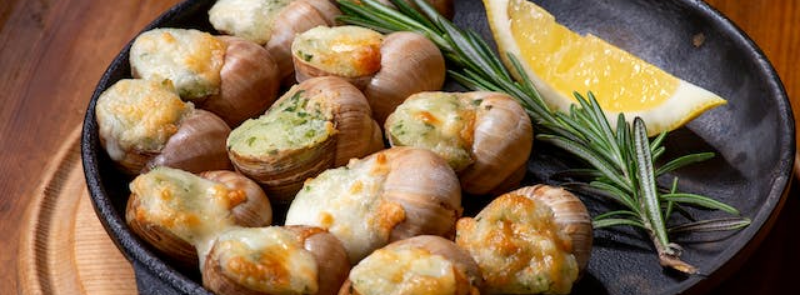
When It Occurs
Every May 24th
Timeline
Days Passed (904)
# Hashtags
#NationalEscargotDay #FrenchCuisine
Prepare to rejoice in the festivities of National Escargot Day on May 24! This distinctive day has been observed since the early 2000s, providing an excellent chance to delve deeper into the world of one of the globe's most revered culinary delights - escargot. With its origins tracing back to Ancient Rome, this delectable dish has captivated the taste buds of various cultures throughout the centuries, spanning from France to Spain and beyond. Its unparalleled flavor and texture promise a delightful culinary adventure. So, equip yourself with a fork, butter, and garlic, and savor the richness of this delectable snail-inspired treat!
What is Escargot?
Escargot, which is the French word for snail, refers to the practice of preparing snails as a dish, often in a sophisticated manner. In French cuisine, escargot is commonly served as an appetizer, typically cooked with garlic butter, herbs, and white wine, and sometimes stuffed back into the shell for presentation. The dish is typically accompanied by bread to soak up the flavorful garlic butter sauce.
History of Escargot
While snails have been consumed as a food source since prehistoric times, their transformation into a culinary delicacy is rooted in European, particularly French, history. Some key points in escargot’s history include:
-
Ancient Origins: Archaeological evidence shows that snails were consumed by early humans as a source of protein. The Romans were known to farm and eat snails, viewing them as a nutritious and easily accessible food.
-
Medieval to Modern France: The French further refined the cooking of escargot, and by the 19th century, it became a staple of haute cuisine, especially in the region of Burgundy, where the dish is a specialty. It is now considered a quintessential French appetizer.
-
Global Spread: While escargot is most associated with French dining, its popularity has spread globally, particularly in gourmet restaurants across Europe and North America.
How Escargot is Prepared
Preparing escargot requires specific techniques and attention to detail. Here’s a basic overview of how the dish is made:
-
Snail Selection: Not all snails are edible. The most common types used for escargot are Helix pomatia (Burgundy snail) and Helix aspersa (garden snail). These snails are typically farm-raised, especially in France, to ensure quality and safety.
-
Purging: Before cooking, snails must be purged, which involves feeding them a bland diet (or fasting them) for a few days to cleanse their digestive system. This process ensures the snails are safe to eat.
-
Cooking Method: The traditional preparation involves removing the snails from their shells, cleaning them thoroughly, and cooking them in a flavorful sauce. A classic French escargot dish often involves garlic butter, parsley, shallots, and sometimes white wine or cognac.
-
Serving: After cooking, the snails are placed back into their cleaned shells and topped with more garlic butter. They are typically served on special escargot plates with indentations for holding each snail shell.
Celebrating National Escargot Day
National Escargot Day is an opportunity for culinary exploration, particularly for those who haven’t tried escargot before. Here are some ways people celebrate the day:
-
Try Escargot: The most obvious way to celebrate is by enjoying escargot at a restaurant. Many French or gourmet restaurants serve the dish as an appetizer, so it’s a perfect time to indulge in this delicacy.
-
Make Escargot at Home: For those feeling adventurous, making escargot at home can be a rewarding culinary experience. Escargot kits are available, which include prepared snails, garlic butter, and even snail shells. Recipes for traditional escargot are widely available online.
-
Learn About French Cuisine: National Escargot Day offers a chance to explore the rich history of French cooking. Escargot is just one element of French gastronomy, so it’s a great excuse to learn about other traditional dishes.
-
Host a Gourmet Dinner: If you enjoy hosting dinner parties, National Escargot Day can be the theme for an elegant gourmet meal. Pair the escargot with other French favorites like cheese, baguettes, and wine for a full dining experience.
Fun Facts About Escargot
- Heliciculture: The farming of snails for food is called heliciculture. Most of the escargot consumed in France is farm-raised, though wild snails are also harvested in some regions.
- High in Protein: Snails are low in fat and high in protein, making them a surprisingly healthy option for those looking to try something new.
- Escargot Utensils: Special utensils are often used to eat escargot. Diners typically use tongs to hold the shell and a small fork to extract the snail.
- Pairing: Escargot is often paired with a crisp white wine, such as Chablis or Sauvignon Blanc, to complement the richness of the garlic butter.
Cultural Significance
While escargot is often considered exotic in the United States, it is a deeply rooted tradition in French culinary culture. In France, escargot is typically enjoyed on special occasions or as part of a multi-course meal. The dish represents not only a dedication to craftsmanship in cooking but also a deep appreciation for local, sustainable food sources.
In the U.S., National Escargot Day is a way to celebrate the influence of French cuisine and to encourage people to step outside their culinary comfort zone.
Conclusion
National Escargot Day provides a unique opportunity for adventurous eaters and those curious about French cuisine to savor a gourmet delicacy. Whether enjoyed at a restaurant, made at home, or simply admired from afar, escargot is a dish that evokes the elegance and sophistication of French dining. On May 24, take a chance to discover the rich flavors and history behind this special appetizer.


